Moran M.J., Shapiro H.N. Fundamentals of Engineering Thermodynamics
Подождите немного. Документ загружается.

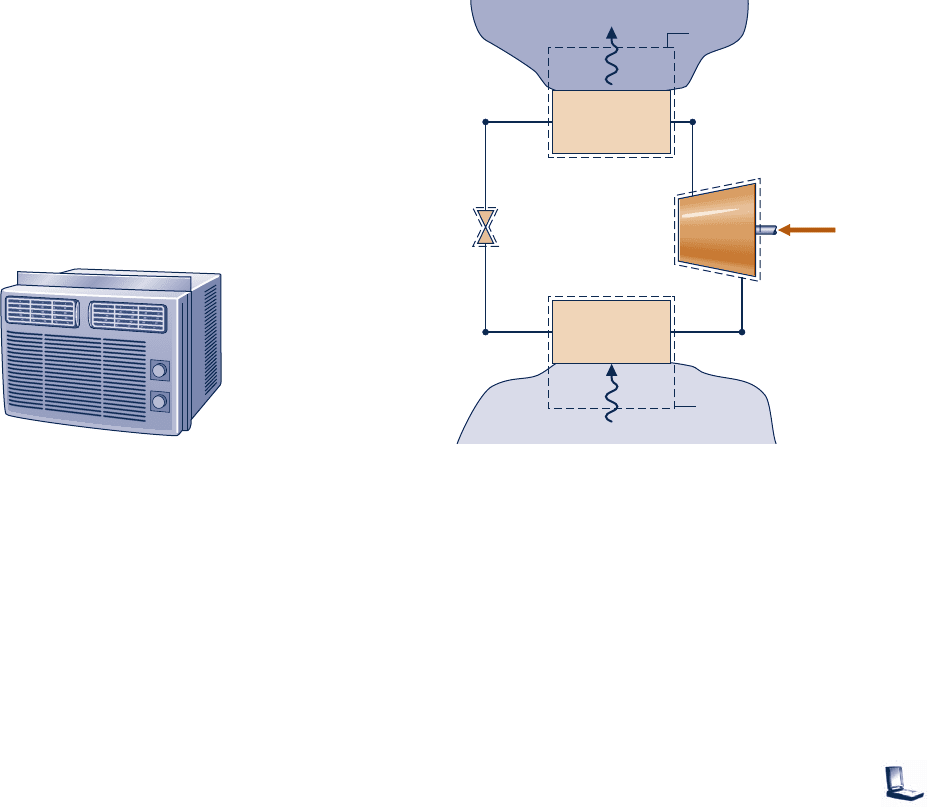
10.24 A window-mounted air conditioner supplies 19 m
3
/min of
air at 158C, 1 bar to a room. Air returns from the room to the
evaporator of the unit at 228C. The air conditioner operates
at steady state on a vapor-compression refrigeration cycle
with Refrigerant-22 entering the compressor at 4 bar, 108C.
Saturated liquid refrigerant at 9 bar leaves the condenser. The
compressor has an isentropic efficiency of 70%, and refrigerant
exits the compressor at 9 bar. Determine the compressor
power, in kW, the refrigeration capacity, in tons, and the
coefficient of performance.
Fig. P10.24
10.25 A vapor-compression refrigeration system for a
household refrigerator has a refrigerating capacity of 1000
Btu/h. Refrigerant enters the evaporator at 2108F and exits
at 08F. The isentropic compressor efficiency is 80%. The
refrigerant condenses at 958F and exits the condenser
subcooled at 908F. There are no significant pressure drops in
the flows through the evaporator and condenser. Determine
the evaporator and condenser pressures, each in lbf/in.
2
, the
mass flow rate of refrigerant, in lb/min, the compressor
power input, in horsepower, and the coefficient of
performance for (a) Refrigerant 134a and (b) propane as the
working fluid.
10.26 A vapor-compression air conditioning system operates
at steady state as shown in Fig. P10.26. The system maintains
a cool region at 608F and discharges energy by heat transfer
to the surroundings at 908F. Refrigerant 134a enters the
compressor as a saturated vapor at 408F and is compressed
adiabatically to 160 lbf/in.
2
The isentropic compressor
efficiency is 80%. Refrigerant exits the condenser as a
saturated liquid at 160 lbf/in.
2
The mass flow rate of the
refrigerant is 0.15 lb/s. Kinetic and potential energy changes
are negligible as are changes in pressure for flow through
the evaporator and condenser. Determine
(a) the power required by the compressor, in Btu/s.
(b) the coefficient of performance.
(c) the rates of exergy destruction in the compressor and
expansion valve, each in Btu/s.
(d) the rates of exergy destruction and exergy transfer
accompanying heat transfer, each in Btu/s, for a control volume
comprising the evaporator and a portion of the cool region
such that heat transfer takes place at T
C
5 5208R (608F).
(e) the rates of exergy destruction and exergy transfer
accompanying heat transfer, each in Btu/s, for a control volume
enclosing the condenser and a portion of the surroundings
such that heat transfer takes place at T
H
5 5508R (908F).
Let T
0
5 5508R.
10.27 A vapor-compression refrigeration cycle with Refrigerant
134a as the working fluid operates with an evaporator
temperature of 508F and a condenser pressure of 180 lbf/in.
2
Saturated vapor enters the compressor. Refrigerant enters
the condenser at 1408F and exits as saturated liquid. The
cycle has a refrigeration capacity of 5 tons. Determine
(a) the refrigerant mass flow rate, in lb/min.
(b) the compressor isentropic efficiency.
(c) the compressor power, in horsepower.
(d) the coefficient of performance.
Plot each of the quantities calculated in parts (b) through
(d) for compressor exit temperatures varying from 1308F
to 1408F.
Cascade and Multistage Systems
10.28 A vapor-compression refrigeration system operates
with the cascade arrangement of Fig. 10.9. Refrigerant 22
is the working fluid in the high-temperature cycle and
Refrigerant 134a is used in the low-temperature cycle. For
the Refrigerant 134a cycle, the working fluid enters the
compressor as saturated vapor at 2308F and is compressed
isentropically to 50 lbf/in.
2
Saturated liquid leaves the
intermediate heat exchanger at 50 lbf/in.
2
and enters the
expansion valve. For the Refrigerant 22 cycle, the working
fluid enters the compressor as saturated vapor at a
temperature 58F below that of the condensing temperature
of the Refrigerant 134a in the intermediate heat exchanger.
The Refrigerant 22 is compressed isentropically to 250 lbf/
in.
2
Saturated liquid then enters the expansion valve at 250
lbf/in.
2
The refrigerating capacity of the cascade system is
20 tons. Determine
(a) the power input to each compressor, in Btu/min.
(b) the overall coefficient of performance of the cascade cycle.
(c) the rate of exergy destruction in the intermediate heat
exchanger, in Btu/min. Let T
0
5 808F, p
0
5 14.7 lbf/in.
2
4
1
32
Condenser
Evaporator
Compressor
Q
out
·
Q
in
·
W
c
·
Surroundings T
H
= 550°R (90°F)
Cool region T
C
= 520°R (60°F)
η
c
= 80%
Saturated vapor
T
1
= 40°F
p
2
= p
3
= 160 lbf/in.
2
Saturated
liquid
p
4
= p
1
T
H
T
C
Expansion
valve
Fig. P10.26
Problems: Developing Engineering Skills 623
c10RefrigerationandHeatPumpSyst623 Page 623 6/21/10 3:29:52 PM user-s146 c10RefrigerationandHeatPumpSyst623 Page 623 6/21/10 3:29:52 PM user-s146 /Users/user-s146/Desktop/Merry_X-Mas/New/Users/user-s146/Desktop/Merry_X-Mas/New
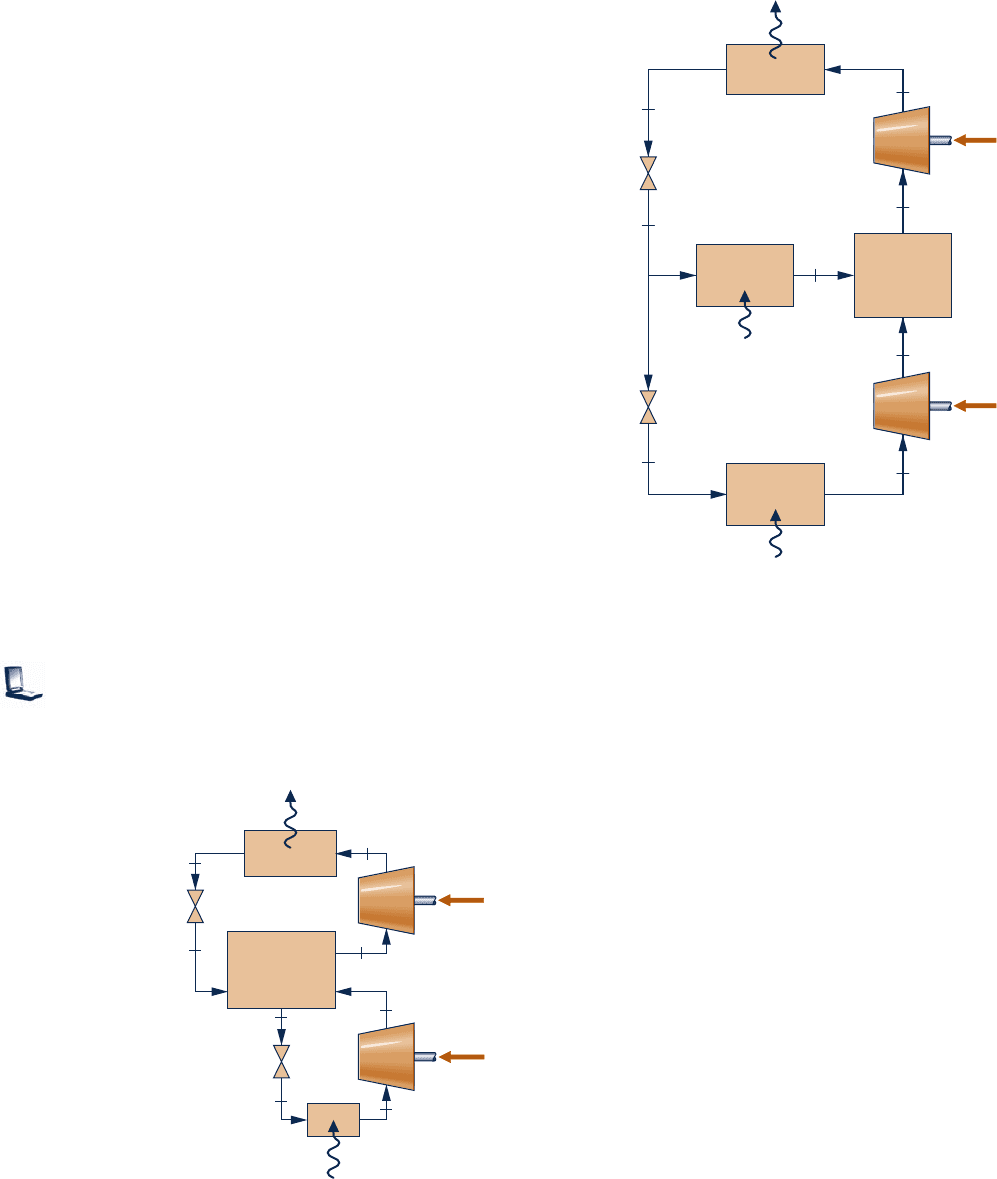
624 Chapter 10
Refrigeration and Heat Pump Systems
10.29 A vapor-compression refrigeration system uses the
arrangement shown in Fig. 10.10 for two-stage compression
with intercooling between the stages. Refrigerant 134a is
the working fluid. Saturated vapor at 2308C enters the
first compressor stage. The flash chamber and direct
contact heat exchanger operate at 4 bar, and the condenser
pressure is 12 bar. Saturated liquid streams at 12 and 4 bar
enter the high- and low-pressure expansion valves,
respectively. If each compressor operates isentropically
and the refrigerating capacity of the system is 10 tons,
determine
(a) the power input to each compressor, in kW.
(b) the coefficient of performance.
10.30 Figure P10.30 shows a two-stage vapor-compression
refrigeration system with ammonia as the working fluid. The
system uses a direct contact heat exchanger to achieve
intercooling. The evaporator has a refrigerating capacity of
30 tons and produces 2208F saturated vapor at its exit. In
the first compressor stage, the refrigerant is compressed
adiabatically to 80 lbf/in.
2
, which is the pressure in the direct
contact heat exchanger. Saturated vapor at 80 lbf/in.
2
enters
the second compressor stage and is compressed adiabatically
to 250 lbf/in.
2
Each compressor stage has an isentropic
efficiency of 85%. There are no significant pressure drops as
the refrigerant passes through the heat exchangers. Saturated
liquid enters each expansion valve. Determine
(a) the ratio of mass flow rates, m
#
3
/
m
#
1
.
(b) the power input to each compressor stage, in horsepower.
(c) the coefficient of performance.
(d) Plot each of the quantities calculated in parts (a)–(c)
versus the direct-contact heat exchanger pressure ranging
from 20 to 200 lbf/in.
2
Discuss.
Condenser
Evaporator
1
2
3
4
5
6
7
8
Expansion
valve
Direct contact
heat exchanger
Expansion
valve
W
c1
·
Q
in
= 30 tons
·
Q
out
W
c2
·
Comp
1
·
Comp
2
Fig. P10.30
Condenser
Evaporator
2
Direct
contact
heat
exchanger
Evaporator
1
Q
out
·
8
Expansion
valve
Expansion
valve
3
6
7
4
5
Q
in,2
= 10 tons
·
Q
in,1
= 5 tons
·
Compressor
2
W
c,2
·
1
2
Compressor
1
W
c,1
·
Fig. P10.31
1 enters compressor 1 at 18 lbf/in.
2
and exits at 70 lbf/in.
2
Evaporator 2 operates at 70 lbf/in.
2
, with saturated vapor
exiting at state 8. The condenser pressure is 200 lbf/in.
2
, and
saturated liquid refrigerant exits the condenser. Each
compressor stage has an isentropic efficiency of 80%. The
refrigeration capacity of each evaporator is shown on the
figure. Sketch the T–s diagram of the cycle and determine
(a) the temperatures, in 8F, of the refrigerant in each
evaporator.
(b) the power input to each compressor stage, in horsepower.
(c) the overall coefficient of performance.
10.32 Figure P10.32 shows the schematic diagram of a vapor-
compression refrigeration system with two evaporators using
Refrigerant 134a as the working fluid. This arrangement is
used to achieve refrigeration at two different temperatures
with a single compressor and a single condenser. The low-
temperature evaporator operates at 2188C with saturated
vapor at its exit and has a refrigerating capacity of 3 tons. The
higher-temperature evaporator produces saturated vapor at
3.2 bar at its exit and has a refrigerating capacity of 2 tons.
Compression is isentropic to the condenser pressure of 10 bar.
There are no significant pressure drops in the flows through
the condenser and the two evaporators, and the refrigerant
leaves the condenser as saturated liquid at 10 bar. Calculate
(a) the mass flow rate of refrigerant through each evaporator,
in kg/min.
(b) the compressor power input, in kW.
(c) the rate of heat transfer from the refrigerant passing
through the condenser, in kW.
10.31 Figure P10.31 shows a two-stage, vapor-compression
refrigeration system with two evaporators and a direct contact
heat exchanger. Saturated vapor ammonia from evaporator
c10RefrigerationandHeatPumpSyst624 Page 624 6/21/10 3:29:56 PM user-s146 c10RefrigerationandHeatPumpSyst624 Page 624 6/21/10 3:29:56 PM user-s146 /Users/user-s146/Desktop/Merry_X-Mas/New/Users/user-s146/Desktop/Merry_X-Mas/New
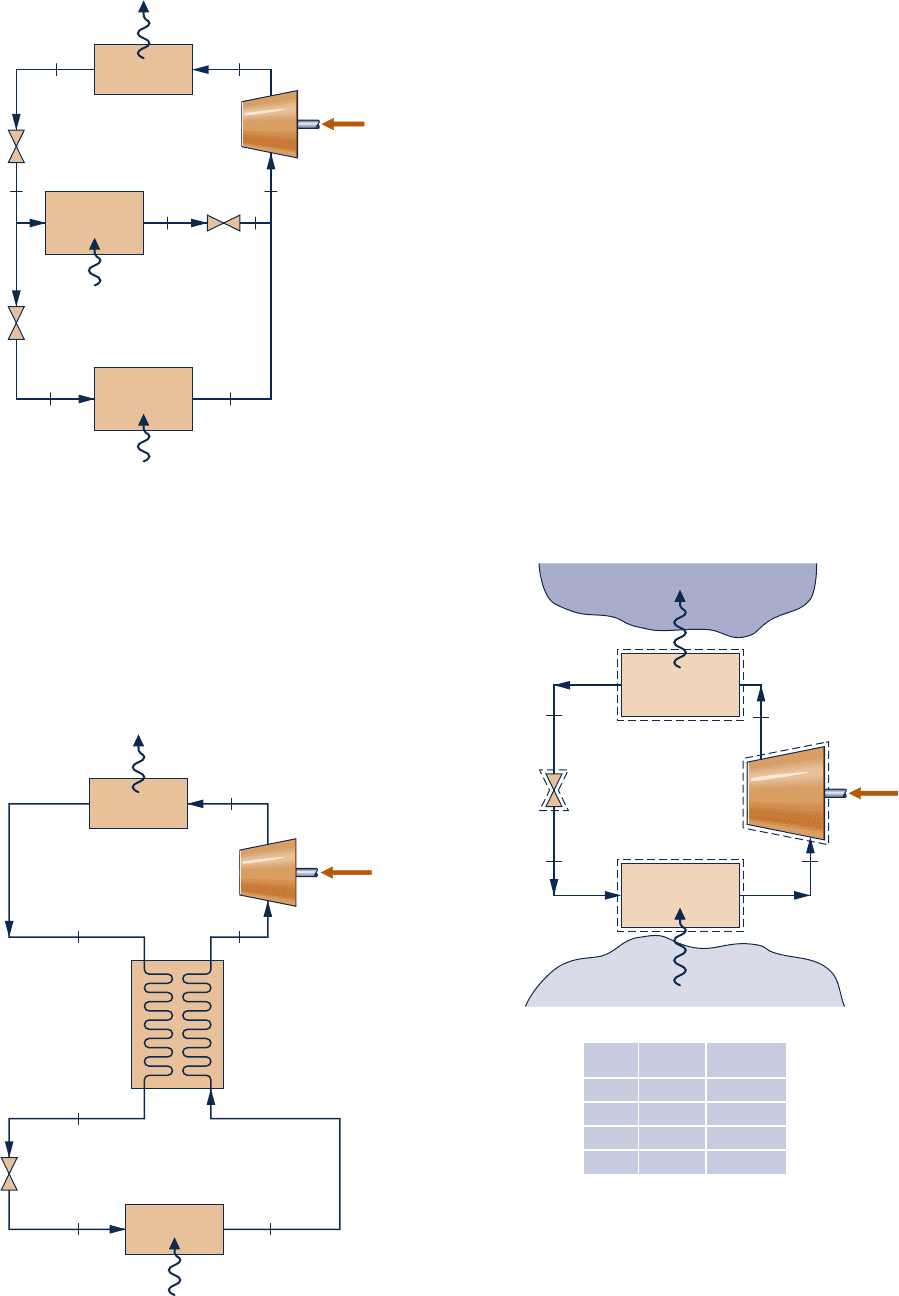
Condenser
Evaporator
2
Evaporator
1
Q
out
·
2
78
56
3
Expansion
valve
Expansion
valve
Expansion
valve
14
Q
in,2
= 2 tons
·
Q
in,1
= 3 tons
·
Compressor
W
c
·
Fig. P10.32
exchanger, entering the expansion valve at 18 bar. If the mass
flow rate of refrigerant is 12 kg/min, determine
(a) the refrigeration capacity, in tons of refrigeration.
(b) the compressor power input, in kW.
(c) the coefficient of performance.
Discuss possible advantages and disadvantages of this
arrangement.
Vapor-Compression Heat Pump Systems
10.34 Figure P10.34 gives data for an ideal vapor-compression
heat pump cycle operating at steady state with Refrigerant
134a as the working fluid. The heat pump provides heating
at a rate of 15 kW to maintain the interior of a building at
208C when the outside temperature is 58C. Sketch the T–s
diagram for the cycle and determine the
(a) temperatures at the principal states of the cycle, each in 8C.
(b) the power input to the compressor, in kW.
(c) the coefficient of performance.
(d) the coefficient of performance for a Carnot heat pump
cycle operating between reservoirs at the building interior and
outside temperatures, respectively.
Compare the coefficients of performance determined in (c)
and (d). Discuss
10.33 An ideal vapor-compression refrigeration cycle is modified
to include a counterflow heat exchanger, as shown in Fig.
P10.33. Ammonia leaves the evaporator as saturated vapor at
1.0 bar and is heated at constant pressure to 58C before
entering the compressor. Following isentropic compression to
18 bar, the refrigerant passes through the condenser, exiting
at 408C, 18 bar. The liquid then passes through the heat
W
c
·
Condenser
Evaporator
Compressor
Heat exchanger
Q
out
·
Q
in
·
2
1
4
3
56
Expansion
valve
Fig. P10.33
Problems: Developing Engineering Skills 625
Condenser
Evaporator
Compressor
Saturated liquid
Saturated vapor
Q
out
= 15 kW
·
Q
in
·
W
c
·
Building interior T
H
= 20°C = 293 K
T
C
= 5°C = 278 K
Outside
Expansion
valve
3
4 1
2
State
1
2
3
4
244.09
268.97
93.42
93.42
h (kJ/kg)p (bar)
2.4
8
8
2.4
Fig. P10.34
10.35 Refrigerant 134a is the working fluid in a vapor-compression
heat pump system with a heating capacity of 60,000 Btu/h. The
condenser operates at 200 lbf/in.
2
, and the evaporator temperature
is 08F. The refrigerant is a saturated vapor at the evaporator exit
and a liquid at 1108F at the condenser exit. Pressure drops in the
c10RefrigerationandHeatPumpSyst625 Page 625 6/21/10 3:30:00 PM user-s146 c10RefrigerationandHeatPumpSyst625 Page 625 6/21/10 3:30:00 PM user-s146 /Users/user-s146/Desktop/Merry_X-Mas/New/Users/user-s146/Desktop/Merry_X-Mas/New
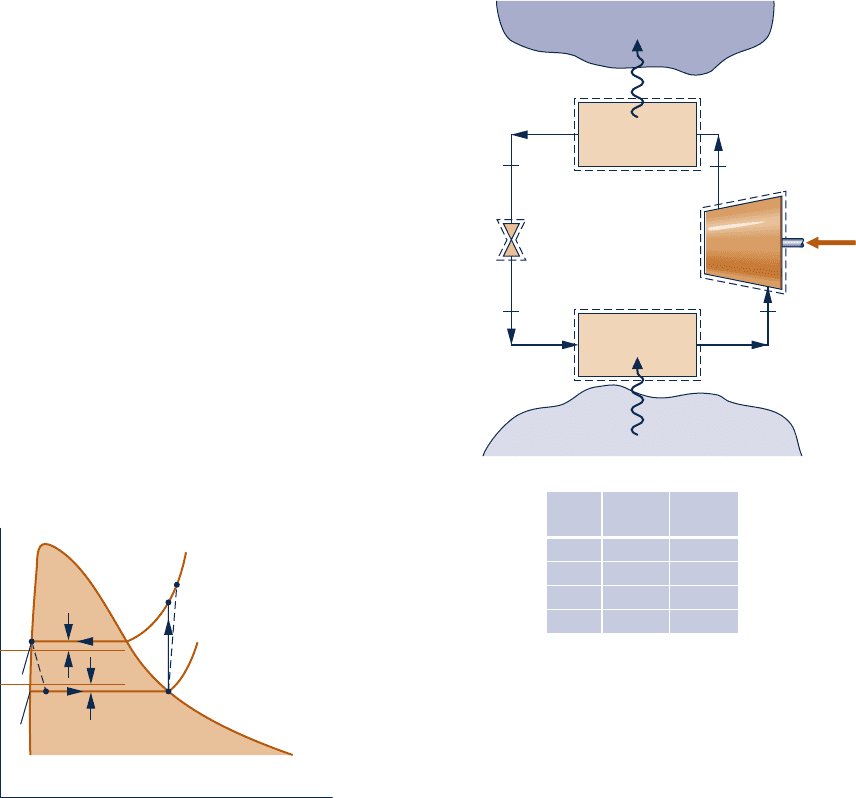
626 Chapter 10
Refrigeration and Heat Pump Systems
flows through the evaporator and condenser are negligible. The
compression process is adiabatic, and the temperature at the
compressor exit is 1808F. Determine
(a) the mass flow rate of refrigerant, in lb/min.
(b) the compressor power input, in horsepower.
(c) the isentropic compressor efficiency.
(d) the coefficient of performance.
10.36 Refrigerant 134a is the working fluid in a vapor-
compression heat pump that provides 35 kW to heat a dwelling
on a day when the outside temperature is below freezing.
Saturated vapor enters the compressor at 1.6 bar, and saturated
liquid exits the condenser, which operates at 8 bar. Determine,
for isentropic compression
(a) the refrigerant mass flow rate, in kg/s.
(b) the compressor power, in kW.
(c) the coefficient of performance.
Recalculate the quantities in parts (b) and (c) for an
isentropic compressor efficiency of 75%.
10.37 An office building requires a heat transfer rate of 20
kW to maintain the inside temperature at 218C when the
outside temperature is 08C. A vapor-compression heat pump
with Refrigerant 134a as the working fluid is to be used to
provide the necessary heating. The compressor operates
adiabatically with an isentropic efficiency of 82%. Specify
appropriate evaporator and condenser pressures of a cycle
for this purpose assuming DT
cond
5 DT
evap
5 108C, as shown
in Figure P10.37. The states are numbered as in Fig. 10.13.
The refrigerant exits the evaporator as saturated vapor and
exits the condenser as saturated liquid at the respective
pressures. Determine the
(a) mass flow rate of refrigerant, in kg/s.
(b) compressor power, in kW.
(c) coefficient of performance and compare with the
coefficient of performance for a Carnot heat pump cycle
operating between reservoirs at the inside and outside
temperatures, respectively.
compression heat pump be used to develop the process
heating using a wastewater stream at 1258F as the lower-
temperature source. Figure P10.39 provides data for this
cycle operating at steady state. The compressor isentropic
efficiency is 80%. Sketch the T–s diagram for the cycle and
determine the
(a) specific enthalpy at the compressor exit, in Btu/lb.
(b) temperatures at each of the principal states, in 8F.
(c) mass flow rate of the refrigerant, in lb/h.
(d) compressor power, in Btu/h.
(e) coefficient of performance and compare with the
coefficient of performance for a Carnot heat pump cycle
operating between reservoirs at the process temperature and
the wastewater temperature, respectively.
3
T
s
4
1
21°C
0°C
2s
2
⌬T
cond
⌬T
evap
Fig. P10.37
Condenser
Evaporator
Compressor
c
= 80%
Q
out
= 3 ⫻ 10
6
Btu/h
·
Q
in
·
W
c
·
Process T
H
= 170°F
T
C
= 125°F
Wastewater
Expansion
valve
3
4 1
2
State
1
2
3
4
116.74
?
76.11
76.11
180
400
400
180
p
(lbf/in.
2
)
h
(Btu/lb)
Fig. P10.39
10.38 Repeat the calculations of Problem 10.37 for Refrigerant
22 as the working fluid. Compare the results with those of
Problem 10.37 and discuss.
10.39 A process requires a heat transfer rate of 3 3 10
6
Btu/h
at 1708F. It is proposed that a Refrigerant 134a vapor-
10.40 A vapor-compression heat pump with a heating capacity
of 500 kJ/min is driven by a power cycle with a thermal
efficiency of 25%. For the heat pump, Refrigerant 134a is
compressed from saturated vapor at 2108C to the condenser
pressure of 10 bar. The isentropic compressor efficiency is
80%. Liquid enters the expansion valve at 9.6 bar, 348C. For
the power cycle, 80% of the heat rejected is transferred to
the heated space.
(a) Determine the power input to the heat pump compressor,
in kW.
(b) Evaluate the ratio of the total rate that heat is delivered
to the heated space to the rate of heat input to the power
cycle. Discuss.
c10RefrigerationandHeatPumpSyst626 Page 626 9/24/10 3:38:04 PM user-s146 c10RefrigerationandHeatPumpSyst626 Page 626 9/24/10 3:38:04 PM user-s146 /Users/user-s146/Desktop/Merry_X-Mas/New/Users/user-s146/Desktop/Merry_X-Mas/New
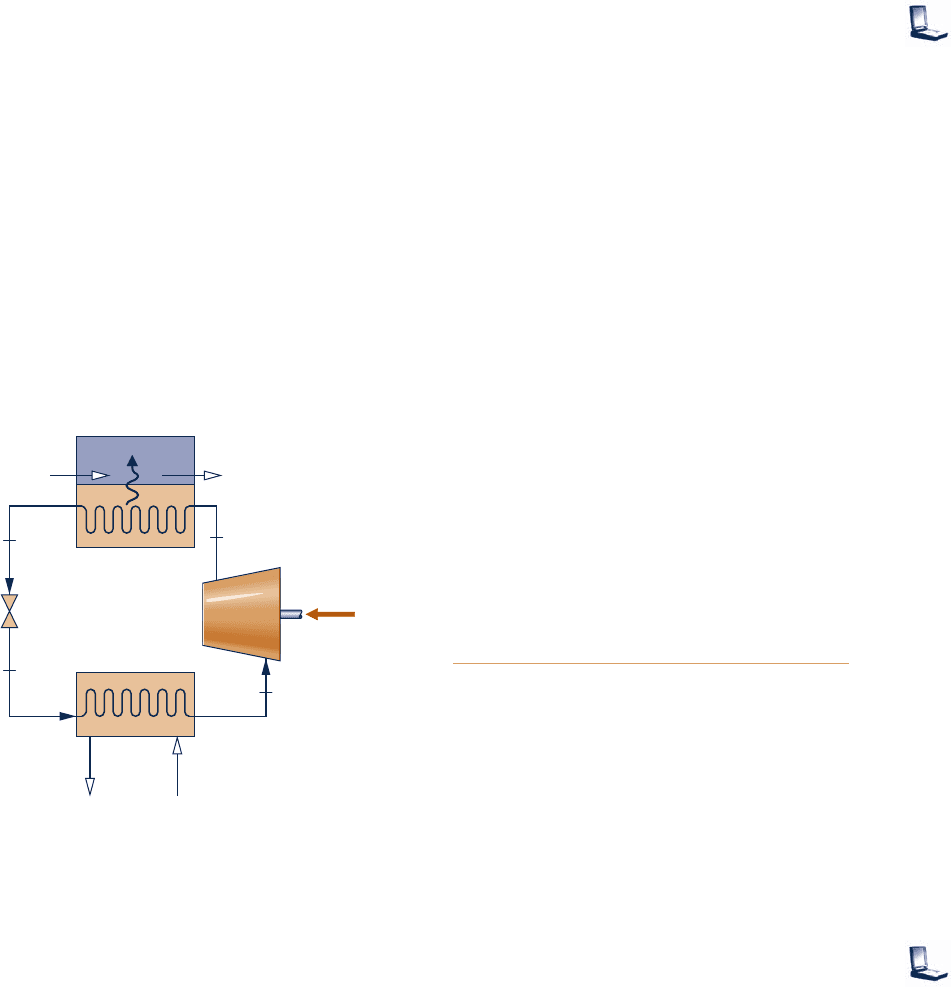
10.41 Refrigerant 134a enters the compressor of a vapor-
compression heat pump at 15 lbf/in.
2
, 08F and is compressed
adiabatically to 160 lbf/in.
2
, 1608F. Liquid enters the expansion
valve at 160 lbf/in.
2
, 958F. At the valve exit, the pressure is
15 lbf/in.
2
(a) Determine the isentropic compressor efficiency.
(b) Determine the coefficient of performance.
(c) Perform a full exergy accounting of the compressor
power input, in Btu per lb of refrigerant flowing. Discuss.
Let T
0
5 4808R.
10.42 A geothermal heat pump operating at steady state with
Refrigerant-22 as the working fluid is shown schematically in Fig.
P10.42. The heat pump uses 558F water from wells as the thermal
source. Operating data are shown on the figure for a day in which
the outside air temperature is 208F. Assume adiabatic operation
of the compressor. For the heat pump, determine
(a) the volumetric flow rate of heated air to the house, in
ft
3
/min.
(b) the isentropic compressor efficiency.
(c) the compressor power, in horsepower.
(d) the coefficient of performance.
(e) the volumetric flow rate of water from the geothermal
wells, in gal/min.
For T
0
5 208F, perform a full exergy accounting of the
compressor power input, and devise and evaluate a second
law efficiency for the heat pump system.
10.44 Air enters the compressor of a Brayton refrigeration
cycle at 100 kPa, 270 K. The compressor pressure ratio is 3,
and the temperature at the turbine inlet is 315 K. The
compressor and turbine have isentropic efficiencies of 82%
and 85%, respectively. Determine the
(a) net work input, per unit mass of air flow, in kJ/kg.
(b) exergy accounting of the net power input, in kJ per kg
of air flowing. Discuss.
Let T
0
5 315 K.
10.45 Plot the quantities calculated in parts (a) through (c) of
Problem 10.43 versus the compressor pressure ratio ranging
from 3 to 6. Repeat for compressor and turbine isentropic
efficiencies of 90%, 85%, and 80%.
10.46 An ideal Brayton refrigeration cycle has a compressor
pressure ratio of 6. At the compressor inlet, the pressure and
temperature of the entering air are 20 lbf/in.
2
and 4608R. The
temperature at the inlet of the turbine is 7008R. For a
refrigerating capacity of 15 tons, determine
(a) the mass flow rate, in lb/min.
(b) the net power input, in Btu/min.
(c) the coefficient of performance.
10.47 Reconsider Problem 10.46, but include in the analysis
that the compressor and turbine have isentropic efficiencies
of 78% and 92%, respectively.
10.48 The table below provides steady-state operating data
for an ideal Brayton refrigeration cycle with air as the working
fluid. The principal states are numbered as in Fig. 10.15. The
volumetric flow rate at the turbine inlet is 0.4 m
3
/s. Sketch
the T–s diagram for the cycle and determine the
(a) specific enthalpy, in kJ/kg, at the turbine exit.
(b) mass flow rate, in kg/s.
(c) net power input, in kW.
(d) refrigeration capacity, in kW.
(e) coefficient of performance.
State p (kPa) T (K) h (kJ/kg) p
r
1 140 270 270.11 0.9590
2 420 — 370.10 2.877
3 420 320 320.29 1.7375
4 140 — ? —
10.49 Air enters the compressor of a Brayton refrigeration
cycle at 100 kPa, 260 K, and is compressed adiabatically to
300 kPa. Air enters the turbine at 300 kPa, 300 K, and
expands adiabatically to 100 kPa. For the cycle
(a) determine the net work per unit mass of air flow, in kJ/kg,
and the coefficient of performance if the compressor and
turbine isentropic efficiencies are both 100%.
(b) plot the net work per unit mass of air flow, in kJ/kg, and
the coefficient of performance for equal compressor and
turbine isentropic efficiencies ranging from 80 to 100%.
10.50 The Brayton refrigeration cycle of Problem 10.43 is
modified by the introduction of a regenerative heat
exchanger. In the modified cycle, compressed air enters
the regenerative heat exchanger at 350 K and is cooled
Condenser
Return air
from house
Heated air
to house
70°F
Evaporator
Condenser
Q
out
= 4.2 tons
·
W
c
·
Water from
geothermal wells
enters at 55°F
Water
discharged
at 45°F
Expansion
valve
110°F
p
1
= 70 lbf/in.
2
T
1
= 40°F
p
4
= 70 lbf/in.
2
1
p
2
= 180 lbf/in.
2
T
2
= 140°F
2
4
p
3
= 180 lbf/in.
2
T
3
= 75 °F
3
Fig. P10.42
Problems: Developing Engineering Skills 627
Gas Refrigeration Systems
10.43 Air enters the compressor of an ideal Brayton
refrigeration cycle at 100 kPa, 300 K. The compressor pressure
ratio is 3.75, and the temperature at the turbine inlet is 350 K.
Determine the
(a) net work input, per unit mass of air flow, in kJ/kg.
(b) refrigeration capacity, per unit mass of air flow, in kJ/kg.
(c) coefficient of performance.
(d) coefficient of performance of a Carnot refrigeration
cycle operating between thermal reservoirs at T
C
5 300 K
and T
H
5 350 K, respectively.
c10RefrigerationandHeatPumpSyst627 Page 627 9/24/10 3:42:05 PM user-s146 c10RefrigerationandHeatPumpSyst627 Page 627 9/24/10 3:42:05 PM user-s146 /Users/user-s146/Desktop/Merry_X-Mas/New/Users/user-s146/Desktop/Merry_X-Mas/New
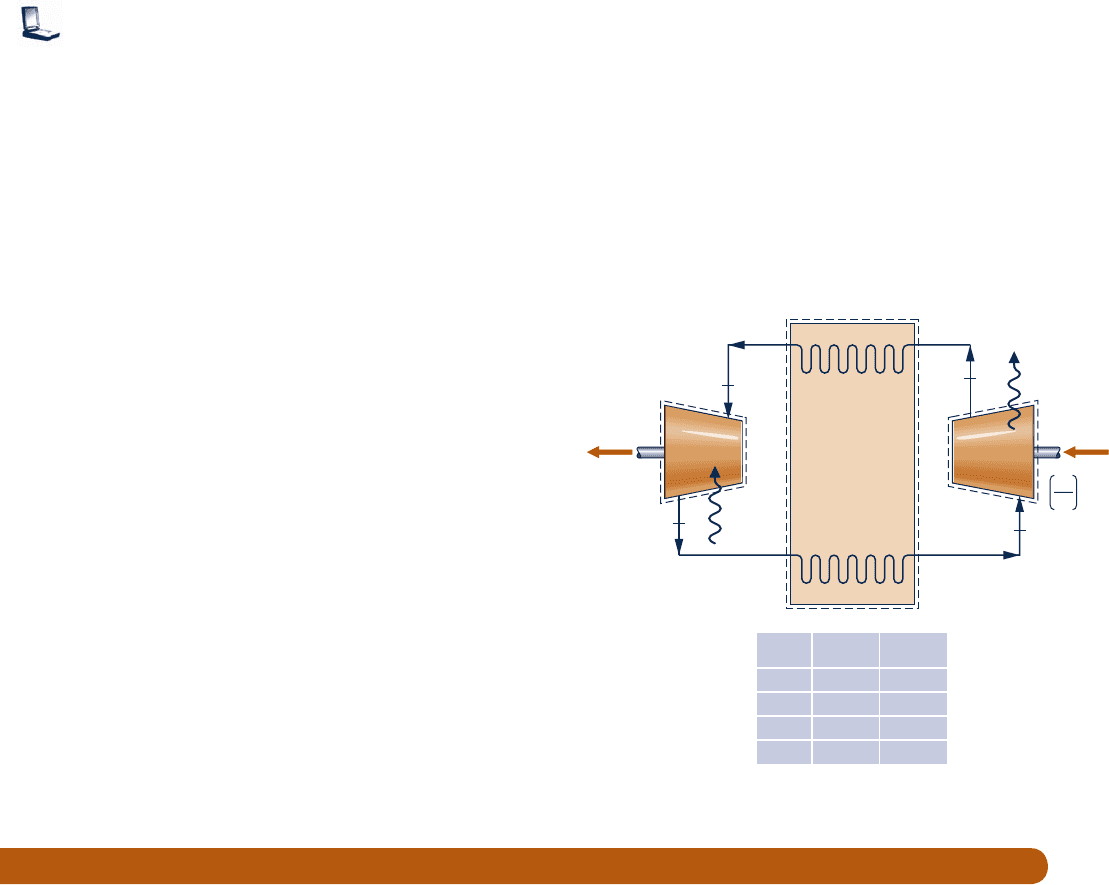
628 Chapter 10 Refrigeration and Heat Pump Systems
to 320 K before entering the turbine. Determine, for the
modified cycle,
(a) the lowest temperature, in K.
(b) the net work input per unit mass of air flow, in kJ/kg.
(c) the refrigeration capacity, per unit mass of air flow, in kJ/kg.
(d) the coefficient of performance.
10.51 Reconsider Problem 10.50, but include in the analysis
that the compressor and turbine have isentropic efficiencies
of 85 and 88% respectively. Answer the same questions as
in Problem 10.50.
10.52 Plot the quantities calculated in parts (a) through (d) of
Problem 10.50 versus the compressor pressure ratio ranging
from 4 to 7. Repeat for equal compressor and turbine isentropic
efficiencies of 95%, 90%, and 80%.
10.53 Consider a Brayton refrigeration cycle with a regenerative
heat exchanger. Air enters the compressor at 4808R, 15 lbf/in.
2
and is compressed isentropically to 40 lbf/in.
2
Compressed
air enters the regenerative heat exchanger at 5408R and is
cooled to 4808R before entering the turbine. The expansion
through the turbine is isentropic. If the refrigeration capacity
is 15 tons, calculate
(a) the volumetric flow rate at the compressor inlet, in ft
3
/min.
(b) the coefficient of performance.
10.54 Reconsider Problem 10.53, but include in the analysis
that the compressor and turbine each have isentropic
efficiencies of 88%. Answer the same questions for the
modified cycle as in Problem 10.53.
10.55 Air at 2 bar, 380 K is extracted from a main jet engine
compressor for cabin cooling. The extracted air enters a heat
exchanger where it is cooled at constant pressure to 320 K
through heat transfer with the ambient. It then expands
adiabatically to 0.95 bar through a turbine and is discharged
into the cabin. The turbine has an isentropic efficiency of
75%. If the mass flow rate of the air is 1.0 kg/s, determine
(a) the power developed by the turbine, in kW.
(b) the rate of heat transfer from the air to the ambient, in kW.
10.56 Air at 32 lbf/in.
2
, 6808R is extracted from a main jet
engine compressor for cabin cooling. The extracted air enters
a heat exchanger where it is cooled at constant pressure to
600°R through heat transfer with the ambient. It then
expands adiabatically to 14 lbf/in.
2
through a turbine and is
discharged into the cabin at 5008R with a mass flow rate of
200 lb/min. Determine
(a) the power developed by the turbine, in horsepower.
(b) the isentropic turbine efficiency.
(c) the rate of heat transfer from the air to the ambient, in
Btu/min.
10.57 Air within a piston–cylinder assembly undergoes a Stirling
refrigeration cycle, which is the reverse of the Stirling power
cycle introduced in Sec. 9.8.4. At the beginning of the isothermal
compression, the pressure and temperature are 100 kPa and
350 K, respectively. The compression ratio is 7, and the temperature
during the isothermal expansion is 150 K. Determine the
(a) heat transfer for the isothermal compression, in kJ per kg
of air.
(b) net work for the cycle, in kJ per kg of air.
(c) coefficient of performance.
10.58 Air undergoes an Ericsson refrigeration cycle, which is the
reverse of the Ericsson power cycle introduced in Sec. 9.8.4.
Figure P10.58 provides data for the cycle operating at steady
state. Sketch the p–y diagram for the cycle and determine the
(a) heat transfer for the isothermal expansion, per unit mass
of air flow, in kJ/kg.
(b) net work, per unit mass of air flow, in kJ/kg.
(c) coefficient of performance.
3
4
2
1
Ideal regenerator
Air
Turbine Compressor
Q
out
·
Q
in
·
W
c
·
W
t
·
= 3.5
p
2
p
1
State
1
2
3
4
310
310
270
270
T (K)p (kPa)
100
350
350
100
Fig. P10.58
c DESIGN & OPEN-ENDED PROBLEMS: EXPLORING ENGINEERING PRACTICE
10.1D Children may wonder how a household refrigerator
works to keep food cold in a warm kitchen. Prepare a 20-
minute presentation suitable for an elementary school
science class to explain the principles of operation of a
refrigerator. Include instructional aids to enhance your
presentation.
10.2D The object of this project is to select a compact
thermoelectric refrigerator to be shared by you and at least
two other students living in the same residence as you do.
Survey the other students to determine their needs in order
to size the unit. Critically evaluate competing brands. What
type and number of thermoelectric modules are used in the
unit selected, and what is its power requirement? Summarize
your findings in a memorandum.
10.3D In cases involving cardiac arrest, stroke, heart attack, and
hyperthermia, hospital medical staff must move quickly to
c10RefrigerationandHeatPumpSyst628 Page 628 6/21/10 3:30:13 PM user-s146 c10RefrigerationandHeatPumpSyst628 Page 628 6/21/10 3:30:13 PM user-s146 /Users/user-s146/Desktop/Merry_X-Mas/New/Users/user-s146/Desktop/Merry_X-Mas/New
Design & Open-Ended Problems: Exploring Engineering Practice 629
reduce the patient’s body temperature by several degrees. A
system for this purpose featuring a disposable plastic body suit
is described in BIOCONNECTIONS in Sec. 4.9.1. Conduct a
search of the patent literature for alternative ways to achieve
cooling of medically distressed individuals. Consider patents
both granted and pending. Critically evaluate two different
methods found in your search relative to each other and the
body suit approach. Write a report including at least three
references.
10.4D Identify and visit a local facility that uses cold thermal
storage. Conduct a forensic study to determine if the cold
storage system is well-suited for the given application today.
Consider costs, effectiveness in providing the desired cooling,
contribution to global climate change, and other pertinent
issues. If the cold storage system is well suited for the
application, document that. If the cold storage system is not
well suited, recommend system upgrades or an alternative
approach for obtaining the desired cooling. Prepare a
PowerPoint presentation of your findings.
10.5D A vertical, closed-loop geothermal heat pump is under
consideration for a new 50,000-ft
2
school building. The design
capacity is 100 tons for both heating and cooling. The local
water table is 150 ft, and the ground water temperature is
558F. Specify a ground source heat pump as well as the
number and depth of wells for this application and develop
a layout of vertical wells and piping required by the system.
10.6D Investigate the economic feasibility of using a waste
heat-recovery heat pump for domestic water heating that
employs ventilation air being discharged from a dwelling as
the source. Assume typical hot water use of a family of four
living in a 2200-ft
2
single-family dwelling in your locale.
Write a report of your findings.
10.7D Food poisoning is on the rise and can be fatal. Many of
those affected have eaten recently at a restaurant, café, or
fast-food outlet serving food that has not been cooled properly
by the food supplier or restaurant food-handlers. To be safe,
foods should not be allowed to remain in the temperature
range where bacteria most quickly multiply. Standard
refrigerators typically do not have the ability to provide the
rapid cooling needed to ensure dangerous levels of bacteria
are not attained. A food processing company supplying a wide
range of fish products to restaurants has requested your
project group to provide advice on how to achieve best cooling
practices in its factory. In particular, you are asked to consider
applicable health regulations, suitable equipment, typical
operating costs, and other pertinent issues. A written report
providing your recommendations is required, including an
annotated list of food-cooling Dos and Don’ts for restaurants
supplied by the company with fish.
10.8D According to researchers, advances in nanomaterial
fabrication are leading to development of tiny thermoelectric
modules that could be used in various applications, including
integrating nanoscale cooling devices within the uniforms
of firefighters, emergency workers, and military personnel;
embedding thermoelectric modules in facades of a building;
and using thermoelectric modules to recover waste heat in
automobiles. Research two applications for this technology
proposed within the past five years. Investigate the technical
readiness and economic feasibility for each concept. Report
your findings in an executive summary and a PowerPoint
presentation with at least three references.
10.9D In induced hypothermia, the temperature of a particular
organ, such as the heart, is lowered to reduce the metabolic
rate during surgery. Cooling is achieved by circulating
blood through a heat exchanger outside the body. When
the cooled blood is reintroduced through blood vessels in
the organ, it cools the organ to the desired temperature.
Develop the preliminary design of a vapor-compression
refrigeration system to cool blood during heart surgery.
Determine the necessary temperature requirements and
specify a refrigerant, operating pressures and temperatures
for the working fluid, and the refrigeration capacity.
10.10D A vapor-compression refrigeration system operating
continuously is being considered to provide a minimum of 80
tons of refrigeration for an industrial refrigerator maintaining
a space at 28C. The surroundings to which the system rejects
energy by heat transfer reach a maximum temperature of 408C.
For effective heat transfer, the system requires a temperature
difference of at least 208C between the condensing refrigerant
and surroundings and between the vaporizing refrigerant and
refrigerated space. The project manager wishes to install a
system that minimizes the annual cost for electricity (monthly
electricity cost is fixed at 5.692 cents for the first 250 kW ? h
and 6.006 cents for any usage above 250 kW ? h). You are
asked to evaluate two alternative designs: a standard vapor-
compression refrigeration cycle and a vapor-compression
refrigeration cycle that employs a power-recovery turbine in
lieu of an expansion valve. For each alternative, consider three
refrigerants: ammonia, Refrigerant 22, and Refrigerant 134a.
Based on electricity cost, recommend the better choice between
the two alternatives and a suitable refrigerant. Other than
electricity cost, what additional factors should the manager
consider in making a final selection? Prepare a written report
including results, conclusions, and recommendations.
10.11D High-performance aircraft increasingly feature
electronics that assist flight crews in performing their duties
and reducing their fatigue. While these electronic devices
improve aircraft performance, they also add greatly to the
thermal load that must be managed within the aircraft.
Cooling technologies currently used on aircraft are
approaching their limits and other means are being considered,
including vapor-compression refrigeration systems. However,
unlike cooling systems used on earth, systems employed on
aircraft must meet rapidly changing conditions. For instance,
as onboard electronic devices switch on and off, the energy
they emit by heat transfer alters the thermal load; additionally,
the temperature of the air outside the aircraft into which such
waste heat is discarded changes with altitude and flight speed.
Accordingly, for vapor-compression systems to be practical
for aircraft use, engineers must determine if the systems can
quickly adapt to rapidly changing thermal loads and
temperatures. The object of this project is to develop the
preliminary design of a bench-top laboratory set-up with
which to evaluate the performance of a vapor-compression
refrigeration system subject to broadly variable thermal
inputs and changing ambient conditions. Document your
design in a report having at least three references.
c10RefrigerationandHeatPumpSyst629 Page 629 6/21/10 3:30:16 PM user-s146 c10RefrigerationandHeatPumpSyst629 Page 629 6/21/10 3:30:16 PM user-s146 /Users/user-s146/Desktop/Merry_X-Mas/New/Users/user-s146/Desktop/Merry_X-Mas/New

630
Systems often involve mixtures of several different entities; mixture rules for gases are
provided in Sec. 11.8.
Image Source/Getty Images, Inc.
ENGINEERING CONTEXT As seen in previous chapters, application of thermodynamic principles to
engineering systems requires data for specific internal energy, enthalpy, entropy, and other properties. The
objective of this chapter is to introduce thermodynamic relations that allow u, h, s, and other thermodynamic
properties of simple compressible systems to be evaluated from data that are more readily measured. Pri-
mary emphasis is on systems involving a single chemical species such as water or a mixture such as air. An
introduction to general property relations for mixtures and solutions is also included.
Means are available for determining pressure, temperature, volume, and mass experimentally. In addition,
the relationships between the specific heats c
y
and c
p
and temperature at relatively low pressure are acces-
sible experimentally. Values for certain other thermodynamic properties also can be measured without great
difficulty. However, specific internal energy, enthalpy, and entropy are among those properties that are not
easily obtained experimentally, so we resort to computational procedures to determine values for these.
c11ThermodynamicRelations.indd Page 630 6/21/10 9:33:35 PM user-s146c11ThermodynamicRelations.indd Page 630 6/21/10 9:33:35 PM user-s146 /Users/user-s146/Desktop/Merry_X-Mas/New/Users/user-s146/Desktop/Merry_X-Mas/New

Thermodynamic
Relations
11
When you complete your study of this chapter, you will be able to...
c
calculate p–y–T data using equations of state involving two or more constants.
c
demonstrate understanding of exact differentials involving properties and utilize the
property relations developed from the exact differentials summarized in Table 11.1.
c
evaluate Du, Dh, and Ds, using the Clapeyron equation when considering phase change,
and using equations of state and specific heat relations when considering single
phases.
c
demonstrate understanding of how tables of thermodynamic properties are constructed.
c
evaluate Dh and Ds using generalized enthalpy and entropy departure charts.
c
utilize mixture rules, such as Kay’s Rule, to relate pressure, volume, and temperature of
mixtures.
c
apply thermodynamic relations to multicomponent systems.
LEARNING OUTCOMES
631
c11ThermodynamicRelations.indd Page 631 6/21/10 9:33:39 PM user-s146c11ThermodynamicRelations.indd Page 631 6/21/10 9:33:39 PM user-s146 /Users/user-s146/Desktop/Merry_X-Mas/New/Users/user-s146/Desktop/Merry_X-Mas/New

632 Chapter 11
Thermodynamic Relations
11.1 Using Equations of State
An essential ingredient for the calculation of properties such as the specific internal
energy, enthalpy, and entropy of a substance is an accurate representation of the
relationship among pressure, specific volume, and temperature. The p–y–T relation-
ship can be expressed alternatively: There are tabular representations, as exempli-
fied by the steam tables. The relationship also can be expressed graphically, as in
the p–y–T surface and compressibility factor charts. Analytical formulations, called
equations of state, constitute a third general way of expressing the p–y–T relation-
ship. Computer software such as Interactive Thermodynamics: IT also can be used
to retrieve p–y–T data.
The virial equation and the ideal gas equation are examples of analytical equations
of state introduced in previous sections of the book. Analytical formulations of the
p–y–T relationship are particularly convenient for performing the mathematical oper-
ations required to calculate u, h, s, and other thermodynamic properties. The object
of the present section is to expand on the discussion of p–y–T relations for simple
compressible substances presented in Chap. 3 by introducing some commonly used
equations of state.
11.1.1
Getting Started
Recall from Sec. 3.11 that the virial equation of state can be derived from the principles
of statistical mechanics to relate the p–y–T behavior of a gas to the forces between
molecules. In one form, the compressibility factor Z is expanded in inverse powers
of specific volume as
Z 5 1 1
B1T
2
y
1
C1T
2
y
2
1
D1T
2
y
3
1
. . .
(11.1)
The coefficients B, C, D, etc. are called, respectively, the second, third, fourth, etc.
virial coefficients. Each virial coefficient is a function of temperature alone. In prin-
ciple, the virial coefficients are calculable if a suitable model for describing the forces
of interaction between the molecules of the gas under consideration is known. Future
advances in refining the theory of molecular interactions may allow the virial coef-
ficients to be predicted with considerable accuracy from the fundamental properties
of the molecules involved. However, at present, just the first few coefficients can be
calculated and only for gases consisting of relatively simple molecules. Equation 11.1
also can be used in an empirical fashion in which the coefficients become parameters
whose magnitudes are determined by fitting p–y–T data in particular realms of inter-
est. Only a few coefficients can be found this way, and the result is a truncated equa-
tion valid only for certain states.
In the limiting case where the gas molecules are assumed not to interact in any
way, the second, third, and higher terms of Eq. 11.1 vanish and the equation reduces
to Z 5 1. Since Z 5 py
/
RT, this gives the ideal gas equation of state py 5 R
/
T. The
ideal gas equation of state provides an acceptable approximation at many states,
including but not limited to states where the pressure is low relative to the critical
pressure and/or the temperature is high relative to the critical temperature of the
substance under consideration. At many other states, however, the ideal gas equation
of state provides a poor approximation.
Over 100 equations of state have been developed in an attempt to improve on
the ideal gas equation of state and yet avoid the complexities inherent in a full
virial series. In general, these equations exhibit little in the way of fundamental
physical significance and are mainly empirical in character. Most are developed
TAKE NOTE...
Using the generalized com-
pressibility chart, virial equa-
tions of state and the ideal
gas model are introduced
in Chap. 3. See Secs. 3.11
and 3.12.
equations of state
virial equation
c11ThermodynamicRelations.indd Page 632 6/22/10 7:29:42 PM user-s146c11ThermodynamicRelations.indd Page 632 6/22/10 7:29:42 PM user-s146 /Users/user-s146/Desktop/Merry_X-Mas/New/Users/user-s146/Desktop/Merry_X-Mas/New
